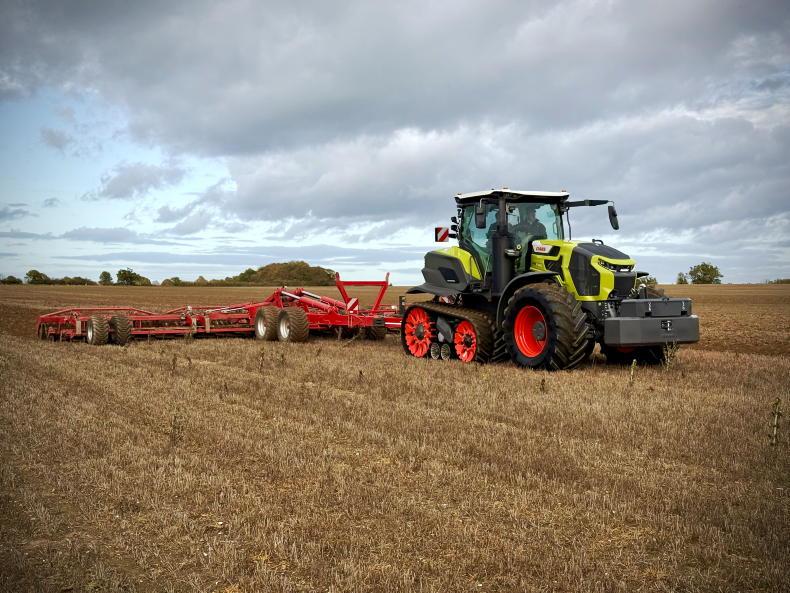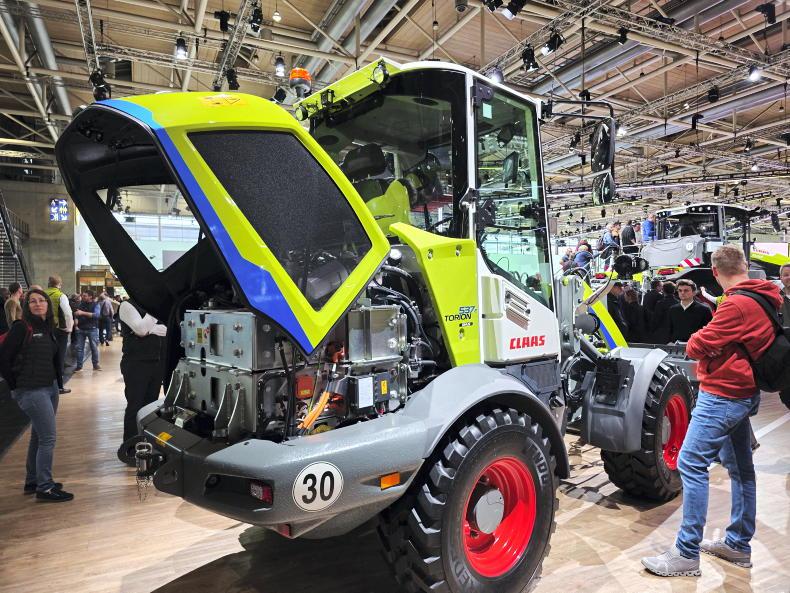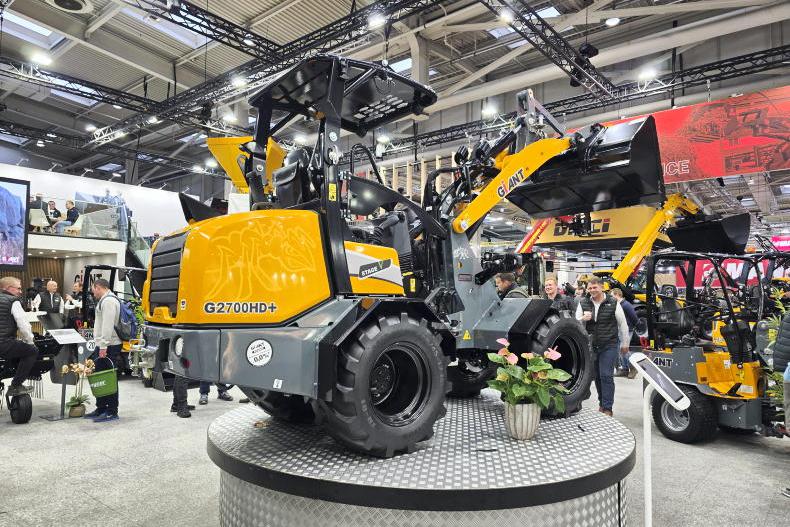In 2018, Claas entered the wheel loader market through a partnership with Liebherr which has seen them churn out more than 1,000 units so far. The manufacturer has now renewed its medium-sized Torion series with the introduction of the new 1285, 1611 and 1611P models. Updates include more engine and hydrostatic drive power, enhanced comfort and a new Z-kinematic system. The updates mean the Torion range now encompasses three series with 11 models, covering operating weights from 4.6t to 20t and engine power from 46hp to 245hp.
More power
The three new models have greater engine power and larger drive pumps and hydrostats. The Torion 1285 has 157hp, and replaces the outgoing 1177 and 1410 models with 137hp and 165hp respectively. The 1611 is increased to 207hp, 23hp more than the 1511 it replaces, while the 1611 P has an increase of 45hp to 252hp. Claas says that thanks to the speed reduction, a higher torque is now available at low speeds. The manufacturer explained that the extra drive torque and power has been designed for silage use and similar applications.
The loader has three driving ranges, with both axial piston pumps being connected in the series for driving ranges I and II. On the road in driving range III, only one pump is used and the engine speed is also lowered to achieve 40km/h at 1,600 rpm.
New Z-kinematics
Following on from higher lifting and holding capacity updates to the Torion 1913 and 2014, the new features have now made their way down through the series. A new Z linkage with more flicking power for silage work means the headstock switches from a welded to a cast steel construction.
Claas says the new Z-kinematics offers significantly more lifting power, especially in the lower lifting range, as well as more holding power in the upper lifting range. Lift volumes up to 4.5m3 with a high bulk density and up to 7m3 with a low bulk density are available with the light goods bucket, and up to 4.5m3 with the high-tip bucket.
More capacity means the Dana Spicer axles on the 1611 and 1611 P have also been reinforced. The operating weight has increased to 15,810kg and 15,200kg respectively, while the 1285 has an operating weight of 13,570kg.
Optional features include bucket return, saved positions for automatic lifting height and lowering depth, tipping assistant, a weighing device and a shaking function.
Scorpion gets a facelift
For 2023, the Scorpion telehandlers have received a comprehensive facelift. Improvements have been made to operator comfort, while the smaller models now feature new engines with more power. Also built by Liebherr since the split with Kramer, the range is now made up of six models with 143hp and 156hp engines covering a range from 7.5t to 11.7t operating weight, 7m to almost 9m stacking height and 3,200kg to 6,000kg lifting capacity.
More engine power
The entire Scorpion model series is powered by four-cylinder engines from Deutz. The 3.6l Stage V engine in the 732, 736, 741 and 746 models have been optimised, meaning each model has 50Nm more torque and a 6hp increase in power. The models are fitted with a new cooling pack and air filter, while the Stage V after treatment is more compact, and has been relocated for better access.

Updates to the Scorpion range include improved operator comfort and new more powerful engines in smaller models.
The 741, 736 and 732 models have been fitted with the hydrostatic Varipower 2 drive from the Jaguar range since 2021. The twin-motor compact drive unit has three driving ranges available: 0 to 20 km/h, 0 to 30 km/h and 0 to 40 km/h. An automatic parking brake is standard, as is a braking assistant for uphill and downhill gradients.
The larger 960 to 746 models are equipped with automatic telescopic boom arm retraction when lowering. From now, all Scorpion models have regenerative working hydraulics. The load-free lowering is decoupled from the engine speed.
When attaching and detaching implements, drivers now benefit from pressure relief. Inside the cab sees a new air conditioning system and an ergonomic steering column with indicator reset.
Central Tyre Inflation systems
Claas has revised its standard CTIC (Claas Tyre Inflation Control) and CTIC 2800 central tyre inflation systems. The system and its development date back to 2017, when Claas purchased a small German company called R&M Landtechniksysteme, who had developed a retrofit tyre inflation system. Two years later, Claas introduced its own branded CTIC system.

Claas has revised its standard CTIC and CTIC 2800 central tyre inflation systems.
This system has been again updated, and today is available for installation from the Arion 500 up to the Axion 900 models.
We got to grips with the system in action in north-western Germany on an Axion 870. The CTIC 2800 system is the latest development. It is controlled using the Cebis terminal, or through an IsoBus terminal. It offers operators the option of adjusting front and rear tyre pressures independently from inside the cab to suit different tasks and ballast requirements.
Claas representatives took great pride in claiming that their system is unrivalled, with up to 2,800l/min air flow rate, capable of inflating four tyres (710/70 R42 on rear) from 0.8 bar to 1.4 bar in 68 seconds. It equates with a 1 bar pressure increase in 90 seconds. Optionally, the 2800 system can be specified with a rear air coupling for implements equipped with a CTIF system, while several attachment profiles can be stored through the control system.
The air is sourced from a hydraulically powered 2,800cc compressor which is mounted on the right-hand side of the cab, above the steps. The seals of the rotary unions and the lines are only loaded during pressure changes. Meanwhile, the standard CTIC compressor is a 90cc engine-driven unit.
The new-generation units can be retrofitted to standard 500, 600, 800 and 900 Arion and Axions, regardless of the year of manufacture. Prices start in the region of €10,000 plus VAT.
New terminal
Claas has rolled out a new Cemis 1200 terminal to replace its previous and outdated S10 universal terminal. The receiver and control technology used in the terminal was developed through a partnership with Trimble.

The new Cemis 1200 terminal replaces the previous and outdated S10 universal terminal.
After initially appearing on the new Trion combine range, Claas has now added the option across its tractor, combine and forager ranges. In addition to automated steering, the new 12in terminal touchscreen handles online documentation, Isobus and task applications, section control (up to 80 sections) and variable rate application. The working areas and views for automated steering, site-specific quantity control and documentation can now be freely configured.
The Cemis 1200 comes with the SAT 900 multi GNSS receiver, which sees the receiver and support sensors combined in one component.
Claas says the SAT 900 supports all correction signals (SATCOR by Trimble RTX worldwide; EGNOS for Europe; RTK NET and RTK ready, SBAS for America and Japan) and enables the use of GPS, GLONASS, Galileo and BEIDOU.
The receiver and terminal can be exchanged between different machines in a fleet. A five-year licence for the SATCOR 15 correction signal by Trimble RTX is included as standard, which enables an accuracy of +/ – 15 cm.
Multifunctional Isobus
In addition to the GPS Pilot for automated steering, the unit includes the Isobus UT/AUX-N and ISO Task Controller TC-BAS functionalities for controlling Isobus attachments, as well as online file transfer for data transmission.
TC-BAS allows the import and export of work orders with reference tracks, field boundaries and activities in ISO-XML format in conjunction with a farm management program. In connection with telematics, work orders can be exchanged online.
Having briefly used the unit, it appears to be sharp and crisp, and a breath of fresh air in comparison to the previous S10, which had become a little outdated in recent years.
In 2018, Claas entered the wheel loader market through a partnership with Liebherr which has seen them churn out more than 1,000 units so far. The manufacturer has now renewed its medium-sized Torion series with the introduction of the new 1285, 1611 and 1611P models. Updates include more engine and hydrostatic drive power, enhanced comfort and a new Z-kinematic system. The updates mean the Torion range now encompasses three series with 11 models, covering operating weights from 4.6t to 20t and engine power from 46hp to 245hp.
More power
The three new models have greater engine power and larger drive pumps and hydrostats. The Torion 1285 has 157hp, and replaces the outgoing 1177 and 1410 models with 137hp and 165hp respectively. The 1611 is increased to 207hp, 23hp more than the 1511 it replaces, while the 1611 P has an increase of 45hp to 252hp. Claas says that thanks to the speed reduction, a higher torque is now available at low speeds. The manufacturer explained that the extra drive torque and power has been designed for silage use and similar applications.
The loader has three driving ranges, with both axial piston pumps being connected in the series for driving ranges I and II. On the road in driving range III, only one pump is used and the engine speed is also lowered to achieve 40km/h at 1,600 rpm.
New Z-kinematics
Following on from higher lifting and holding capacity updates to the Torion 1913 and 2014, the new features have now made their way down through the series. A new Z linkage with more flicking power for silage work means the headstock switches from a welded to a cast steel construction.
Claas says the new Z-kinematics offers significantly more lifting power, especially in the lower lifting range, as well as more holding power in the upper lifting range. Lift volumes up to 4.5m3 with a high bulk density and up to 7m3 with a low bulk density are available with the light goods bucket, and up to 4.5m3 with the high-tip bucket.
More capacity means the Dana Spicer axles on the 1611 and 1611 P have also been reinforced. The operating weight has increased to 15,810kg and 15,200kg respectively, while the 1285 has an operating weight of 13,570kg.
Optional features include bucket return, saved positions for automatic lifting height and lowering depth, tipping assistant, a weighing device and a shaking function.
Scorpion gets a facelift
For 2023, the Scorpion telehandlers have received a comprehensive facelift. Improvements have been made to operator comfort, while the smaller models now feature new engines with more power. Also built by Liebherr since the split with Kramer, the range is now made up of six models with 143hp and 156hp engines covering a range from 7.5t to 11.7t operating weight, 7m to almost 9m stacking height and 3,200kg to 6,000kg lifting capacity.
More engine power
The entire Scorpion model series is powered by four-cylinder engines from Deutz. The 3.6l Stage V engine in the 732, 736, 741 and 746 models have been optimised, meaning each model has 50Nm more torque and a 6hp increase in power. The models are fitted with a new cooling pack and air filter, while the Stage V after treatment is more compact, and has been relocated for better access.

Updates to the Scorpion range include improved operator comfort and new more powerful engines in smaller models.
The 741, 736 and 732 models have been fitted with the hydrostatic Varipower 2 drive from the Jaguar range since 2021. The twin-motor compact drive unit has three driving ranges available: 0 to 20 km/h, 0 to 30 km/h and 0 to 40 km/h. An automatic parking brake is standard, as is a braking assistant for uphill and downhill gradients.
The larger 960 to 746 models are equipped with automatic telescopic boom arm retraction when lowering. From now, all Scorpion models have regenerative working hydraulics. The load-free lowering is decoupled from the engine speed.
When attaching and detaching implements, drivers now benefit from pressure relief. Inside the cab sees a new air conditioning system and an ergonomic steering column with indicator reset.
Central Tyre Inflation systems
Claas has revised its standard CTIC (Claas Tyre Inflation Control) and CTIC 2800 central tyre inflation systems. The system and its development date back to 2017, when Claas purchased a small German company called R&M Landtechniksysteme, who had developed a retrofit tyre inflation system. Two years later, Claas introduced its own branded CTIC system.

Claas has revised its standard CTIC and CTIC 2800 central tyre inflation systems.
This system has been again updated, and today is available for installation from the Arion 500 up to the Axion 900 models.
We got to grips with the system in action in north-western Germany on an Axion 870. The CTIC 2800 system is the latest development. It is controlled using the Cebis terminal, or through an IsoBus terminal. It offers operators the option of adjusting front and rear tyre pressures independently from inside the cab to suit different tasks and ballast requirements.
Claas representatives took great pride in claiming that their system is unrivalled, with up to 2,800l/min air flow rate, capable of inflating four tyres (710/70 R42 on rear) from 0.8 bar to 1.4 bar in 68 seconds. It equates with a 1 bar pressure increase in 90 seconds. Optionally, the 2800 system can be specified with a rear air coupling for implements equipped with a CTIF system, while several attachment profiles can be stored through the control system.
The air is sourced from a hydraulically powered 2,800cc compressor which is mounted on the right-hand side of the cab, above the steps. The seals of the rotary unions and the lines are only loaded during pressure changes. Meanwhile, the standard CTIC compressor is a 90cc engine-driven unit.
The new-generation units can be retrofitted to standard 500, 600, 800 and 900 Arion and Axions, regardless of the year of manufacture. Prices start in the region of €10,000 plus VAT.
New terminal
Claas has rolled out a new Cemis 1200 terminal to replace its previous and outdated S10 universal terminal. The receiver and control technology used in the terminal was developed through a partnership with Trimble.

The new Cemis 1200 terminal replaces the previous and outdated S10 universal terminal.
After initially appearing on the new Trion combine range, Claas has now added the option across its tractor, combine and forager ranges. In addition to automated steering, the new 12in terminal touchscreen handles online documentation, Isobus and task applications, section control (up to 80 sections) and variable rate application. The working areas and views for automated steering, site-specific quantity control and documentation can now be freely configured.
The Cemis 1200 comes with the SAT 900 multi GNSS receiver, which sees the receiver and support sensors combined in one component.
Claas says the SAT 900 supports all correction signals (SATCOR by Trimble RTX worldwide; EGNOS for Europe; RTK NET and RTK ready, SBAS for America and Japan) and enables the use of GPS, GLONASS, Galileo and BEIDOU.
The receiver and terminal can be exchanged between different machines in a fleet. A five-year licence for the SATCOR 15 correction signal by Trimble RTX is included as standard, which enables an accuracy of +/ – 15 cm.
Multifunctional Isobus
In addition to the GPS Pilot for automated steering, the unit includes the Isobus UT/AUX-N and ISO Task Controller TC-BAS functionalities for controlling Isobus attachments, as well as online file transfer for data transmission.
TC-BAS allows the import and export of work orders with reference tracks, field boundaries and activities in ISO-XML format in conjunction with a farm management program. In connection with telematics, work orders can be exchanged online.
Having briefly used the unit, it appears to be sharp and crisp, and a breath of fresh air in comparison to the previous S10, which had become a little outdated in recent years.












SHARING OPTIONS